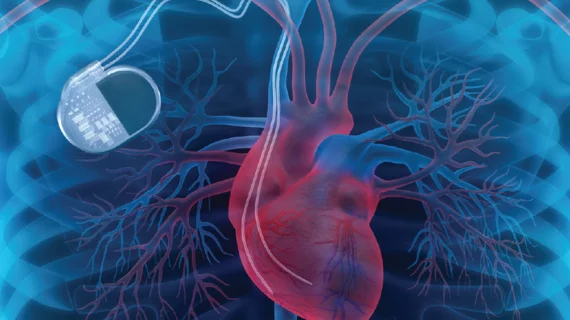Antibacterial envelope cuts risk of CIED infection by 40%
An absorbable, antibiotic-eluting mesh envelope significantly reduced the incidence of major cardiac implantable electronic device (CIED) infections in a recent study of nearly 7,000 patients, researchers reported in the New England Journal of Medicine May 16.
The Worldwide Randomized Antibiotic Envelope Infection Prevention, or WRAP-IT, trial studied the efficacy of Medtronic’s TRYX absorbable antibacterial envelope, a product designed to improve CIED stabilization in the subcutaneous pocket by eluting minocycline and rifampin, two common antibiotics. First author Khaldoun G. Tarakji, MD, MPH, and colleagues said in NEJM that despite doctors’ best efforts at prophylaxis, infections after CIED placement remain overwhelmingly common.
Tarakji, a physician at the Cleveland Clinic, and his team enrolled 6,983 patients in their randomized controlled clinical trial, all of whom were undergoing a CIED pocket revision, generator replacement, system update or initial implantation at the time. Around half were assigned to receive the TRYX envelope, while the other half were randomized to a control group.
The TRYX envelope was developed as a single-use device that holds a CIED for up to nine weeks before reabsorbing into the body. It’s constructed from a multifilament knitted mesh and coated with a polymer that’s mixed with minocycline and rifampin, which are eluted into local tissue for an average of seven days.
The authors said all patients—not just those with the envelope—received standard-of-care strategies to prevent CIED infection, which typically included a preoperative round of antibiotics. The followed up with participants for an average of 20 months, looking for a primary endpoint of infection resulting in system extraction or revision, long-term antibiotic therapy with infection recurrence or death within 12 months of CIED implantation. The study’s safety endpoint was defined as procedure-related or system-related complications in the same period.
Tarakji et al. said 25 patients in the envelope group and 42 patients in the control group met the study’s primary endpoint, corresponding to 12-month Kaplan-Meier estimated event rates of 0.7% and 1.2%, respectively. Another 201 patients in the envelope group and 236 patients in the control group met the safety endpoint—event rates of 6% and 6.9%, respectively.
“The envelope was significantly more effective at preventing infection than standard infection-control strategies alone,” the authors wrote. “The efficacy objective was met, with 40% fewer patients in the envelope group than in the control group having a major infection through 12 months of follow-up. The envelope was successfully implanted in 99.7% of procedure attempts, and the safety objective was met, because the envelope group did not have a higher incidence of CIED procedure-related or system-related complications than the control group.”
Of patients’ initial major infections, the researchers said 17 were endocarditis or bacteremia and 50 were pocket infections. There were fewer pocket infections but more endocarditis or bacteremia infections in the envelope group.
Though the study’s primary and secondary endpoints were restricted to one-year outcomes, Tarakji and colleagues said the entire follow-up period yielded 32 major CIED infections in the envelope group and 51 infections in the control group. They wrote that the 12-month benefits of the envelope seemed most pronounced in patients with higher-power devices, with lower-power ones generating fewer infection rates as a whole, envelope or not.
“CIED infection is a rare but serious event, and its management requires prolonged hospitalization, which involves device and lead extraction with adjunctive antibiotic therapy,” the authors said. “The risk of major complications with lead extraction is low, approximately 1% to 2%, but these can be fatal. These results add to the existing body of literature on the safety and efficacy of the envelope in reducing CIED infections.”

